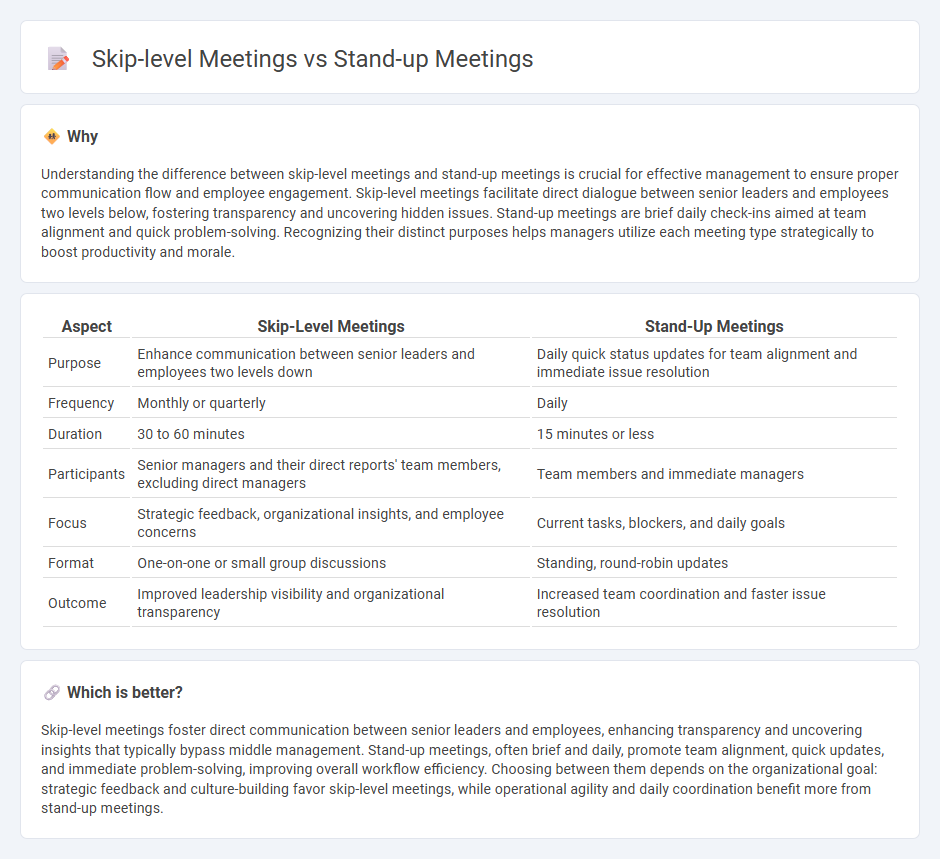
Skip-level meetings foster direct communication between senior leaders and employees two or more levels below, enabling insights into team dynamics and uncovering challenges often missed in daily operations. Stand-up meetings are brief, focused gatherings designed to synchronize team members, track progress, and address immediate obstacles rapidly. Explore how integrating both meeting types can enhance organizational transparency and team productivity.
Why it is important
Understanding the difference between skip-level meetings and stand-up meetings is crucial for effective management to ensure proper communication flow and employee engagement. Skip-level meetings facilitate direct dialogue between senior leaders and employees two levels below, fostering transparency and uncovering hidden issues. Stand-up meetings are brief daily check-ins aimed at team alignment and quick problem-solving. Recognizing their distinct purposes helps managers utilize each meeting type strategically to boost productivity and morale.
Comparison Table
| Aspect | Skip-Level Meetings | Stand-Up Meetings |
|---|---|---|
| Purpose | Enhance communication between senior leaders and employees two levels down | Daily quick status updates for team alignment and immediate issue resolution |
| Frequency | Monthly or quarterly | Daily |
| Duration | 30 to 60 minutes | 15 minutes or less |
| Participants | Senior managers and their direct reports' team members, excluding direct managers | Team members and immediate managers |
| Focus | Strategic feedback, organizational insights, and employee concerns | Current tasks, blockers, and daily goals |
| Format | One-on-one or small group discussions | Standing, round-robin updates |
| Outcome | Improved leadership visibility and organizational transparency | Increased team coordination and faster issue resolution |
Which is better?
Skip-level meetings foster direct communication between senior leaders and employees, enhancing transparency and uncovering insights that typically bypass middle management. Stand-up meetings, often brief and daily, promote team alignment, quick updates, and immediate problem-solving, improving overall workflow efficiency. Choosing between them depends on the organizational goal: strategic feedback and culture-building favor skip-level meetings, while operational agility and daily coordination benefit more from stand-up meetings.
Connection
Skip-level meetings enhance communication by allowing managers to engage directly with employees two levels below, uncovering insights often missed in regular stand-up meetings. Stand-up meetings provide concise, daily updates that keep teams aligned and projects on track, forming a foundation for information flow that skip-level meetings can expand upon. Together, these meetings create a multi-layered communication structure boosting transparency, trust, and operational efficiency within organizations.
Key Terms
Communication
Stand-up meetings enhance team communication by promoting quick, daily updates that align immediate tasks and identify obstacles promptly. Skip-level meetings facilitate open dialogue between leadership and non-direct reports, enabling deeper insights into team dynamics and fostering trust beyond direct supervisors. Explore more to understand how both meeting types can optimize organizational communication.
Hierarchy
Stand-up meetings typically involve direct team members or immediate supervisors, fostering quick status updates and immediate problem-solving within a regular hierarchy level. Skip-level meetings bypass direct supervisors to connect higher-level managers with employees several levels below, promoting open communication and revealing insights otherwise filtered through layers. Discover how balancing both meeting types can enhance organizational transparency and employee engagement.
Collaboration
Stand-up meetings promote daily team collaboration by encouraging quick, focused updates that align immediate tasks and address obstacles. Skip-level meetings enhance cross-hierarchical communication, fostering trust and innovation by allowing leaders to connect directly with team members beyond their immediate reports. Explore how integrating both meeting types can optimize collaboration and drive organizational success.
Source and External Links
What are stand-up meetings? - Stand-up meetings are short, daily gatherings where team members discuss progress, address challenges, and coordinate activities while remaining standing to encourage brevity and focus.
How to run a standup meeting the right way - This article provides best practices for conducting effective stand-up meetings, including keeping them brief and consistent in time and place.
How to Run Effective Stand-Up Meetings - This resource outlines six steps to run effective stand-up meetings, emphasizing participation, structure, and the importance of keeping them brief.
 dowidth.com
dowidth.com